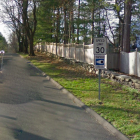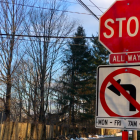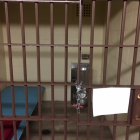Members of the Police Commission said Wednesday night that they’re willing to take a second look at a decision they made last summer to comply with a seldom-observed state law, leading to the elimination of 13 parking spaces on Elm Street.
Prompted by a local attorney’s assertion that there appears to be a relevant 1950 opinion letter from the state attorney general and an appellate court case that could empower the town to find relief from the statute, commissioners said during their regular meeting that they would ask for a formal opinion from municipal counsel. New Canaan lost 13 spaces on Elm Street after a resident put town officials on formal notice about the town’s lack of compliance with a state law requiring a 25-foot buffer between crosswalks and parking spaces. Though local officials at the time asked transportation consultants and the state about what New Canaan might to do find a way out from under the restriction, no path to exemption materialized, and the Police Commission—the town’s on-street parking authority—voted 3-0 at its July 18 meeting to change Elm Street’s parking configuration.
Merchants in the heart of New Canaan bemoaned the loss of parking.
A guest at this week’s Commission meeting, Richard Stewart, said the change has upset him. Saying he’s seen a high number of vacant storefronts on Elm, Stewart told the Commission, “I know they are all under attack from Amazon and the Internet but in New Canaan that is such a vital thing for our town—we don’t have like Darien has a waterfront, we have the 100-acre cent er of town with the retail space and everybody comes in and it becomes a friendlier town.”
According to Stewart, an opinion issued by the Connecticut attorney general in 1950, one year after the statute in question took effect, could give municipalities the ability to pass an ordinance that allows them to get out from under the 25-foot rule. Stewart said he would investigate the option which while it “doesn’t have the power of law, still has power.”
He added that he found an appellate court case where a man fighting a $90 parking ticket was told by the court that he would have the ability to be exempted from the parking rule but that his city didn’t have an exemption on its own books, “so let’s make sure our town does that.”
Stewart said he would return at the Commission’s April 17 meeting with the information.



